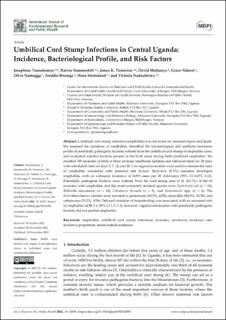Umbilical Cord Stump Infections in Central Uganda: Incidence, Bacteriological Profile, and Risk Factors
Tumuhamye, Josephine; Sommerfelt, Halvor; Tumwine, James K; Mukunya, David; Ndeezi, Grace; Namugga, Olive; Bwanga, Freddie; Steinsland, Hans; Nankabirwa, Victoria
Journal article, Peer reviewed
Published version

Åpne
Permanent lenke
https://hdl.handle.net/11250/3037308Utgivelsesdato
2022Metadata
Vis full innførselSamlinger
Originalversjon
International Journal of Environmental Research and Public Health (IJERPH). 2022, 19 (23), 16055. 10.3390/ijerph192316055Sammendrag
Umbilical cord stump infection (omphalitis) is a risk factor for neonatal sepsis and death. We assessed the incidence of omphalitis, described the bacteriological and antibiotic-resistance profile of potentially pathogenic bacteria isolated from the umbilical cord stump of omphalitis cases, and evaluated whether bacteria present in the birth canal during birth predicted omphalitis. We enrolled 769 neonates at birth at three primary healthcare facilities and followed them for 28 days with scheduled visits on days 3, 7, 14, and 28. Cox regression models were used to estimate the rates of omphalitis associated with potential risk factors. Sixty-five (8.5%) neonates developed omphalitis, with an estimated incidence of 0.095 cases per 28 child-days (95% CI 0.073, 0.12). Potentially pathogenic bacteria were isolated from the cord stump area of 41 (63.1%) of the 65 neonates with omphalitis, and the most commonly isolated species were Escherichia coli (n = 18), Klebsiella pneumoniae (n = 10), Citrobacter freundii (n = 5), and Enterobacter spp. (n = 4). The Enterobacteriaceace isolates were resistant to gentamicin (10.5%, 4/38), ampicillin (86.8%, 33/38), and ceftriaxone (13.2%, 5/38). Delayed initiation of breastfeeding was associated with an increased risk of omphalitis (aHR 3.1; 95% CI 1.3, 7.3); however, vaginal colonization with potentially pathogenic bacteria did not predict omphalitis.
